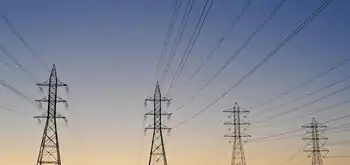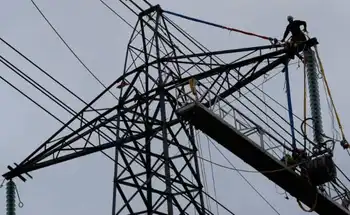Sunshine and sewage to power cities
By Reuters
Protective Relay Training - Basic
Our customized live online or in‑person group training can be delivered to your staff at your location.

- Live Online
- 12 hours Instructor-led
- Group Training Available
Amid the hum of machinery and warm odor of putrefying autumn leaves, official Pierre Hirtzberger is explaining how three giant fermenters can convert household food waste, trimmings from parks and gardens and the slops from school and hospital canteens into enough methane gas to power about a third of the buses in the French city.
"The process is exactly the same as in the stomach of a cow," he said, gesturing toward three biodigesters which each hold 20,000 cubic meters of rotting liquefied waste.
"The objective is to fuel 100 of Lille's buses on this biogas, out of a total fleet of 350," Hirtzberger, head of the city's urban waste research and development, told Reuters.
From San Francisco to Malmo, Sweden, cities around the globe are preparing for a new imperative: to accommodate the mass of world population growth and thrive, without further accelerating the release of carbon dioxide that threatens their existence.
With half the world's population already living in cities and the urban population projected to reach almost five billion by 2030, it is not just growth that puts them in the front line of climate change.
Even if populations escaping drought migrate to urban centers, the fact that 60 per cent of the world's 39 largest metropolises are located in coastal areas puts the cities themselves at risk in future centuries, from rising seas.
Sunshine, tech creativity and a clued-in population help widen the range of options for places like San Francisco — the first city to make it a crime not to compost food and waste in city bins, in a bid to cut landfill use to zero.
Plenty of money on top of abundant sun are allowing Abu Dhabi to showcase a futuristic eco-city: Masdar City is a vision of solar panels powering pilot less taxis and trams and feeding desalinated water to citizens and its verdant palms.
Such visions make dazzling prospectuses for those eyeing a market which analysts expect to be worth a record $200 billion next year, and sunshine will be a major source of clean power as the cost comes down to make it competitive with fossil fuels.
But for many cities, particularly older centers in gloomier climates, the reality will be more like Lille — distilling energy from the excrement of citizens, the waste from restaurants and the mountains of unsold sandwiches left in supermarket fridges at the end of each week.
Much of it will just be plain boring — pumping insulation foam into loft spaces and wall cavities, fitting double or triple glazing — the stuff that can keep small builders busy even if economic slowdown stalls grand construction projects.
In all, it will require myriad different approaches to whittle down society's impact on the planet.
Cities in France, Sweden, Australia and the United States are looking at an exotic mix of energy sources, and their choices prove that what looks good in architects' promotional literature is not necessarily what works on the ground.
In Australia, the government plans seven pioneering "Solar Cities" and is putting $1.5 billion (Australian) into four large power stations driven by the sun.
But a temperate city like Melbourne will have a very different approach from that of sun-bathed Brisbane, 1,700 km north and just 600 km from the Tropic of Capricorn.
"If you're in Brisbane, you'll probably have solar hot water and solar air-conditioning and a bit of electric power as your mix," said Jim Smitham, a renewable energy expert at Australian state research body CSIRO.
"But if you're in Melbourne, you'll be much more interested in heating and power and a little bit of air-conditioning for the summer."
Even within cities, the density of solar generation will vary according the value of land, he added.
In pricey central business districts, solar panels will be stacked on rooftops, but in the suburbs small-scale solar plants will help supplement households' own generation.
Outside the cities, where land is cheapest, solar power stations will find a niche, feeding power into the metropolis.
As solar power costs have fallen due to economies of scale, an initially subsidized power source is becoming viable in some places.
"In countries like Spain, southern Italy and Greece, the cost of energy from solar is already, or will soon be, at parity with the cost of electricity from the grid," said Winfried Hoffmann, president of the European Photovoltaic Industry Association.
"Germany is less sunny so it will take longer, but it will reach parity by 2016 at the latest," he added.
But where Brisbane gets about 2,790 hours of sunlight a year, Lille gets about half that, as moist air sweeps in from the North Atlantic. So Lille is focusing hard on waste.
Biogas — the fuel that will power some Lille buses — is actually an ancient energy source. It captured the attention of 13th-century adventurer Marco Polo in China, where he noted covered pots of sewage stored to generate energy, and it earned a mention by 17th-century writer Daniel Defoe.
Lille is also looking at that option.
"We're studying the possibility of getting biogas from sewage sludge at one of the city's two sewage treatment plants, and that has the potential to do at least 150 more buses," said Hirtzberger.
"Potentially, one could run the entire bus system with biogas from sewage and rubbish. This would be typical of most cities in Europe."
Other cities, such as Malmo, Sweden, use waste to heat and power buildings. In Malmo, 50 percent of heat is produced from its 550,000 metric tons of waste a year — a level that could be replicated in most north European cities, said Richard Bengtsson, project manager of E.ON Nordic, which developed Malmo's heat and power system.
"Waste is an interesting fuel due to the fact that you don't have to pay for it," said Bengtsson. "You get paid to take care of it."
Malmo owes much of its success to an existing network of pipes to carry heated water from the Sysav plant direct to homes and businesses — a highly efficient system most popular in eastern Europe known as "district heating."
The system is also used in the city of Monsteras, 300 km to the northeast, using waste heat from the local pulp mill, Sodra Cell. As an added benefit, the heat from the subterranean pipelines keeps ice from cycle-paths during the winter.
In the Finnish capital Helsinki, a power company is preparing to open an underground data center which will channel excess heat from computers into the district heating network, to warm homes.
Biogas, rather than the heated water used in Malmo and Monsteras, may be a way to avoid digging up the streets of bustling and historic capitals like London or Paris to retrofit pipework.
"Biomethane for the grid has such great opportunities, because it uses the existing infrastructure," said Martin Orrill, head of energy technology and innovation at British Gas.
Biogas is already widely used to generate electricity at sewage works, but putting it into the grid and burning it in homes increases makes it three times as efficient, he added.
Biomethane is already being injected into the gas grid in Germany, France and Austria. And in New York, gas is taken from the Staten Island landfill and injected into the grid.
Most cities will find the answer in a mix.
San Francisco plans to use solar to generate about 5 percent of its power by 2012, mostly from small solar arrays which it is helping to underwrite.
Residents can enter their address into a Web site for an instant estimate on how much money and carbon they could save with solar panels: even new bus stops have solar cells in their red plastic roofs.
The city has just finished a study of small-scale wind turbines that rev up about the time the sun sets, said Adam Browning, executive director of the Vote Solar Initiative that promotes sun power. "It's kind of like peanut butter and jelly," he said.
Next it plans a study of wave power, and this month announced a small-scale hydro plant fed by the mountains to the east, the first in a system that potentially could meet about a tenth of city needs.
Carbon emissions are already 5 percent below 1990 levels and headed toward net zero, said Mayor Gavin Newsom, adding the city's eco-friendly citizens are more tolerant of trying new things such as mandatory composting.
"It was easy," he said of the carbon cuts so far. "It's just not difficult. We need to disenthrall ourselves about how difficult this stuff is."











